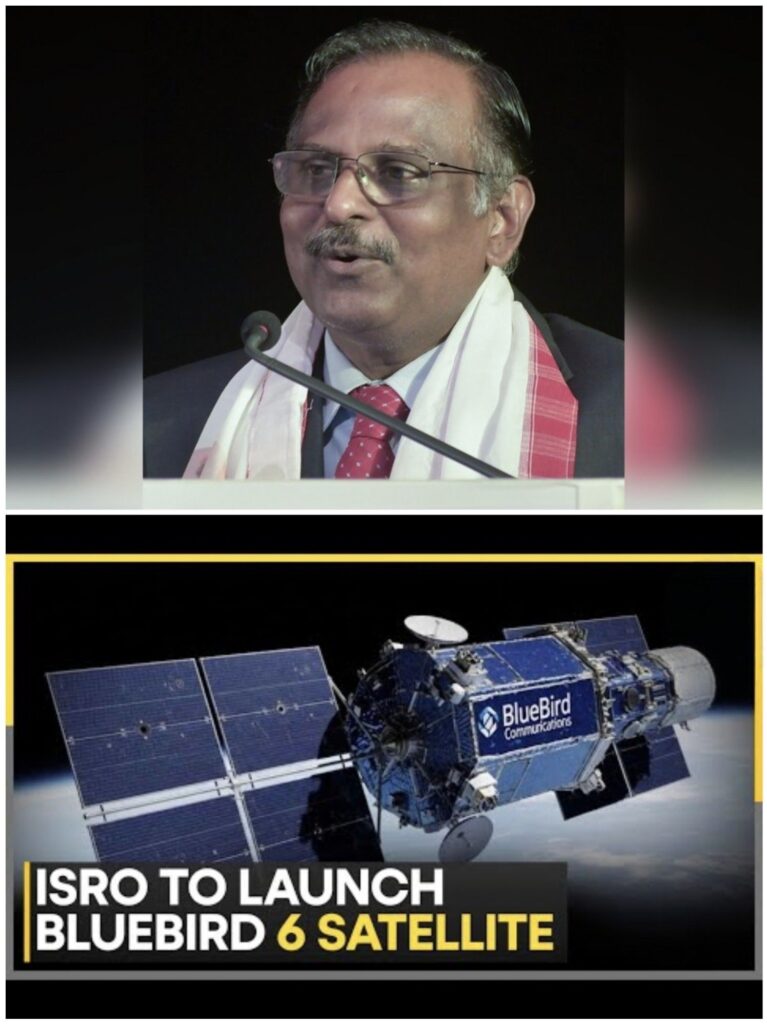New Delhi | October 23,2025 | SKY LINK TIMES
The Indian Space Research Organisation (ISRO) is gearing up for another major international space collaboration, this time with the United States, as it prepares to launch the 6.5-tonne BlueBird-6 communication satellite by the end of 2025. The update was shared by ISRO Chairman Dr. V. Narayanan during a media briefing for the upcoming Emerging Science, Technology and Innovation Conclave (ESTIC) 2025.

Table of Contents
A New Chapter in India–US Space Cooperation
Dr. Narayanan confirmed that the BlueBird-6 satellite, developed by US-based AST SpaceMobile, has already arrived in India on October 19 and will be launched aboard ISRO’s most powerful rocket, LVM3, from the Satish Dhawan Space Centre in Sriharikota.
> “Blue Bird is a communication satellite. We have received the satellite, and we are working for the launch. The launch vehicle build-up is going on,” said Dr. Narayanan.
“The date will be announced by the Prime Minister at the appropriate time. We are targeting to accomplish it before this year’s end,” he added.
The launch will mark another successful step in the growing space partnership between India and the United States, following the NASA–ISRO Synthetic Aperture Radar (NISAR) mission successfully launched earlier this year.
About the BlueBird-6 Satellite
The Block 2 BlueBird-6 is a Low Earth Orbit (LEO) communication satellite weighing 6.5 tonnes, making it one of the heaviest commercial payloads ever to be launched by ISRO. Developed by AST SpaceMobile, the satellite is designed to expand global space-based mobile connectivity, enabling direct communication with standard smartphones without the need for ground-based infrastructure.
Its successful launch aboard LVM3 (Launch Vehicle Mark-3) — the same rocket that carried Chandrayaan-3 — will demonstrate India’s growing capability to handle large-scale, high-value commercial missions for global partners.
ISRO’s Gaganyaan Mission Nearing Completion
Speaking about India’s first human spaceflight programme, Gaganyaan, Dr. Narayanan revealed that 85–90% of subsystem-level work has been completed.
> “We are now conducting integrated tests and software validation. Three uncrewed missions will be launched before the crewed flight to ensure complete safety and reliability,” he said.
The Gaganyaan mission is aimed at sending Indian astronauts into space, marking a major leap in the nation’s human space exploration capability.
ESTIC 2025: Showcasing India’s Scientific Power
The Emerging Science, Technology and Innovation Conclave (ESTIC 2025) will be held from November 3–5 at Bharat Mandapam, New Delhi, and will be inaugurated by Prime Minister Narendra Modi.
The event will bring together 13 science and technology departments, along with industry leaders, startups, and academia, to highlight India’s growing innovation ecosystem.
> “The conclave will showcase our potential, appreciate talent, and understand the vision of each department,” Dr. Narayanan stated.
Also Read:https://skylinktimes.in/india-south-korea-partnership-deepens/
India’s Roadmap to a 2040 Lunar Mission
Adding to India’s future space ambitions, Dr. A. Rajarajan, Director of the Vikram Sarabhai Space Centre (VSSC), revealed that the organisation has begun conceptualizing a Lunar Module Launch Vehicle (LMLV).
The LMLV, currently in its initial design phase, will be capable of lifting 75,000 kg to Low Earth Orbit (LEO) and is intended to enable an Indian astronaut’s landing on the Moon by 2040.
> “Developing a new vehicle is challenging and requires an ecosystem capable of manufacturing advanced components. We are building this capability step by step,” Dr. Rajarajan said.
India’s Rising Space Leadership
With consecutive international missions like NISAR and BlueBird-6, Indian Space Research Organisation continues to establish itself as a trusted global launch partner. These missions underscore India’s growing technological prowess, industrial capability, and strategic ties with the US in the field of space science and innovation.
For More Info Stay Tuned: https://skylinktimes.in



